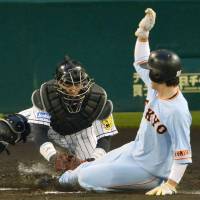Blocking rule causing confusion at home plate
The Japan Times on May 16. 2016 by Jason Coskrey

One of Japanese baseball’s new rules at home plate, or rather the determination to start enforcing one that was technically already in effect, has been the source of some consternation on NPB diamonds.
The new part of the rule is simple enough, with runners basically tasked with avoiding collisions at home plate. This is similar to the rule introduced in the majors in 2014. The existing part, now being enforced after years of being ignored, has been the problem.
Catchers can no longer get away with blocking the plate and must give runners a path to the dish. If they don’t, the runner is ruled safe whether the tag is made in time or not.
The problem is, sometimes whether a catcher blocked the plate or not is a judgment call by the umpires. Because of this, there are going to be instances where the ruling will lead to lengthy arguments with various people seeing the same play different ways. Having umpires make a ruling on something with so much potential gray area was always going to come with a few growing pains.
There have been out calls at the plate overturned in both the Central and Pacific Leagues. Both cases led to lengthy discussions about the rule around the Japanese baseball world.
The latest flare-up, during a game between the Yomiuri Giants and Hanshin Tigers on May 11, set off such a debate. Yomiuri’s Seiji Kobayashi tried to score from second on a two-out single to center by Ryota Wakiya in the third inning. Tigers catcher Fumihito Haraguchi fielded Yamato Maeda’s throw and tagged the runner out, only for the umpires to overturn the ruling and give the Kyojn the run. Predictably incensed, Tigers manager Tomoaki Kanemoto argued to no avail, and Hanshin filed a protest with NPB the next day.
Haraguchi looked to have been slightly straddling the plate before fielding the ball, except that he’d retreated to slightly behind it by the time the ball arrived. There was no collision other than Haraguchi slamming his glove into a sliding Kobayashi’s leg to make the out. Haraguchi’s brief flash across the plate seemed to have been enough to trigger the ruling, even though he wasn’t blocking the plate when the runner arrived. Or he could’ve been deemed too close to the plate as Kobayashi slid home, even though there was still a path to the dish.
If the endgame is to avoid a collision, Haraguchi seemed to have done almost everything right, and the out probably should’ve stood. The question, perhaps, is how close is too close to the plate ball in the umpires’ determination? That’s where judgment can lead to debate, hence the Tigers filing a protest.
Umpires have to be as consistent as possible in applying the rule to limit controversy. Taking away the ability to block the plate will embolden third-base coaches and baserunners, and consistency about what actually constitutes blocking will be of the utmost importance going forward.
“The players are confused, the catchers are confused and it’s hard on the umpires also,” Hall of Famer Isao Harimoto was quoted as saying by Nikkan Sports on television Sunday morning.
Kanemoto said he just wanted things explained properly, which seems to have not happened. Catchers can adjust their positioning, but it’s up to the umpires, and ultimately NPB, to give them direction by making things as black and white as possible to quell any uncertainty before a similar situation arises later in the season, when much more might be hanging in the balance.



